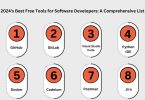Every computer system requires instructions to complete tasks. Both programs and software consist of instructions provided to the computer, directing it to execute specific tasks. A program is a short bit of code that directs the system to accomplish its assigned task. In contrast, software is a collection of programs that provide instructions to the computer, similar to individual programs. Notably, the software has more comprehensive functionalities and features than a single computer program.
Programs and software are critical components of computer systems, although their scope, complexity and functionality differ widely.
Program:
A program is a basic unit of software that consists of precise instructions or ordered directions that are provided to the computer in order to enable it to complete a certain task and achieve a desired result. Individual developers generally write programs that are small, sometimes as little as a single line of code. They lack a user interface and are run by a compiler, which translates source code into object code for execution.
Software:
Software, on the other hand, is a comprehensive collection of programs that execute numerous activities. It contains not only programs but also user instructions, configuration files, installation files and other materials. Software is getting larger and more complicated, necessitating the creation of a team of developers. In contrast to programs, software typically features a user interface, enabling direct interaction with users.
Software is further subdivided into system software and application software.
Application Software:
Application software is created for end-users and performs specific activities, either personal or professional. Users can install and run many application software programs on their PCs at the same time. MS Office, Adobe Reader, web browsers like Google Chrome and multimedia players like VLC are just a few examples.
System Software:
System software supervises and monitors all computer functions, acting as a bridge between hardware and application software. It possesses direct access to computer hardware and can execute application software. Operating systems, firmware, boot loaders and device drivers are some examples.
The Difference between Software and Program
Software:
- A collection of programs or instructions for carrying out activities
- Is written by a user team that includes developers, QA engineers, UI designers and business analysts.
- Large, often ranging from megabytes to gigabytes
- There are countless lines of code that are difficult.
- Developing software demands both additional time and financial resources.
- The usage of higher levels of programming languages.
- Offers either a command line interface (CLI) or a graphical user interface (GUI).
- The software encompasses various features and functionalities since it is a compilation of programs.
- Software can be acquired from the internet and installed on a computer even without a specific program.
- The software can be a program that operates in general.
- The execution is determined by the operating system.
- Already compiled and tested in development
Program:
- A set of instructions for performing a specific task.
- A single user can write it.
- Small, often ranging from kilobytes to gigabytes
- It has the potential to be either a block of code or a single line of code, depending on the context and requirement.
- It takes less time and money to develop a program.
- Typical-level programming languages are employed.
- There is no user interface.
- Features are limited.
- A program cannot operate on a computer if no software is installed.
- A single program cannot exist.
- The compiler determines execution.
- Compile and generate output every time.
Final Thoughts:
In the intricate world of computing, programs and software stand as unpopular heroes, providing the essential instructions that enable our machines to perform tasks efficiently. Programs, akin to concise snippets of code, serve as the building blocks, while software emerges as the intricate tapestry weaving together various programs, user instructions and configuration files into seamless functionality. This collaboration of code and interface shapes our digital experiences, whether through the streamlined activities of application software like MS Office and Adobe Reader, or the foundational role of system software such as operating systems and device drivers. While programs are the elemental architects of specific tasks, software stands as the grand orchestrator, harmonizing the complexity of countless lines of code into user-friendly interfaces. Programs and software enhance our comprehension of the technology driving our daily activities.








